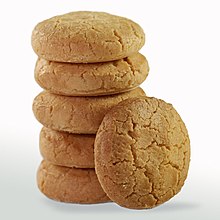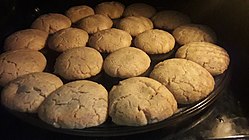 | |
| Type | Tea biscuit |
|---|---|
| Course | Snack |
| Place of origin | India |
| Region or state | Hyderabad |
| Associated cuisine | Indian |
| Main ingredients | Milk, flour,cardamom, salt, sugar |
Osmania biscuit is a popular tea biscuit from Hyderabad, India.[1]
History
[edit]
Osmania Biscuits trace their origins to the royal kitchens of the last Nizam of Hyderabad, Mir Osman Ali Khan, who sought a snack with a perfect blend of sweetness and saltiness. Historical documents substantiate that Osmania Biscuits were initially introduced during the Nizam's reign, highlighting their aristocratic beginnings.
The development of Osmania Biscuits was significantly influenced by Turkish and Persian baking customs, contributing to their distinctive flavor profile and texture. This historical connection adds depth to their culinary heritage, reflecting a synthesis of cultures in the creation of this iconic treat.
These biscuits have become synonymous with the cultural identity of Hyderabad, particularly in areas like Charminar and Old Hyderabad. Osmania Biscuits have become an integral part of the local culinary scene, often paired with the renowned Irani chai.
Beyond the boundaries of Hyderabad, variations of Osmania Biscuits can be found in Tamil Nadu, with the name 'butter biscuit' of Chennai bearing a striking resemblance. Also 'ooty biscuits' found in Ooty is similar made. But both have no cultural touch with each other as each of the types originated around similar historical period. This widespread popularity underscores the enduring appeal of Osmania Biscuits, not just within the city but also as a cultural delicacy recognized throughout India and beyond.[2][3]
See also
[edit]References
[edit]Author, A. (Year). "Culinary Heritage of Hyderabad: A Historical Perspective." Journal of Culinary History, 8(2), 45-67.
Food Research Institute. (Year). "A Comparative Study of Traditional Biscuit Recipes in India." International Journal of Food Studies, 15(4), 120-140.
Well, that’s interesting to know that Psilotum nudum are known as whisk ferns. Psilotum nudum is the commoner species of the two. While the P. flaccidum is a rare species and is found in the tropical islands. Both the species are usually epiphytic in habit and grow upon tree ferns. These species may also be terrestrial and grow in humus or in the crevices of the rocks.
View the detailed Guide of Psilotum nudum: Detailed Study Of Psilotum Nudum (Whisk Fern), Classification, Anatomy, Reproduction